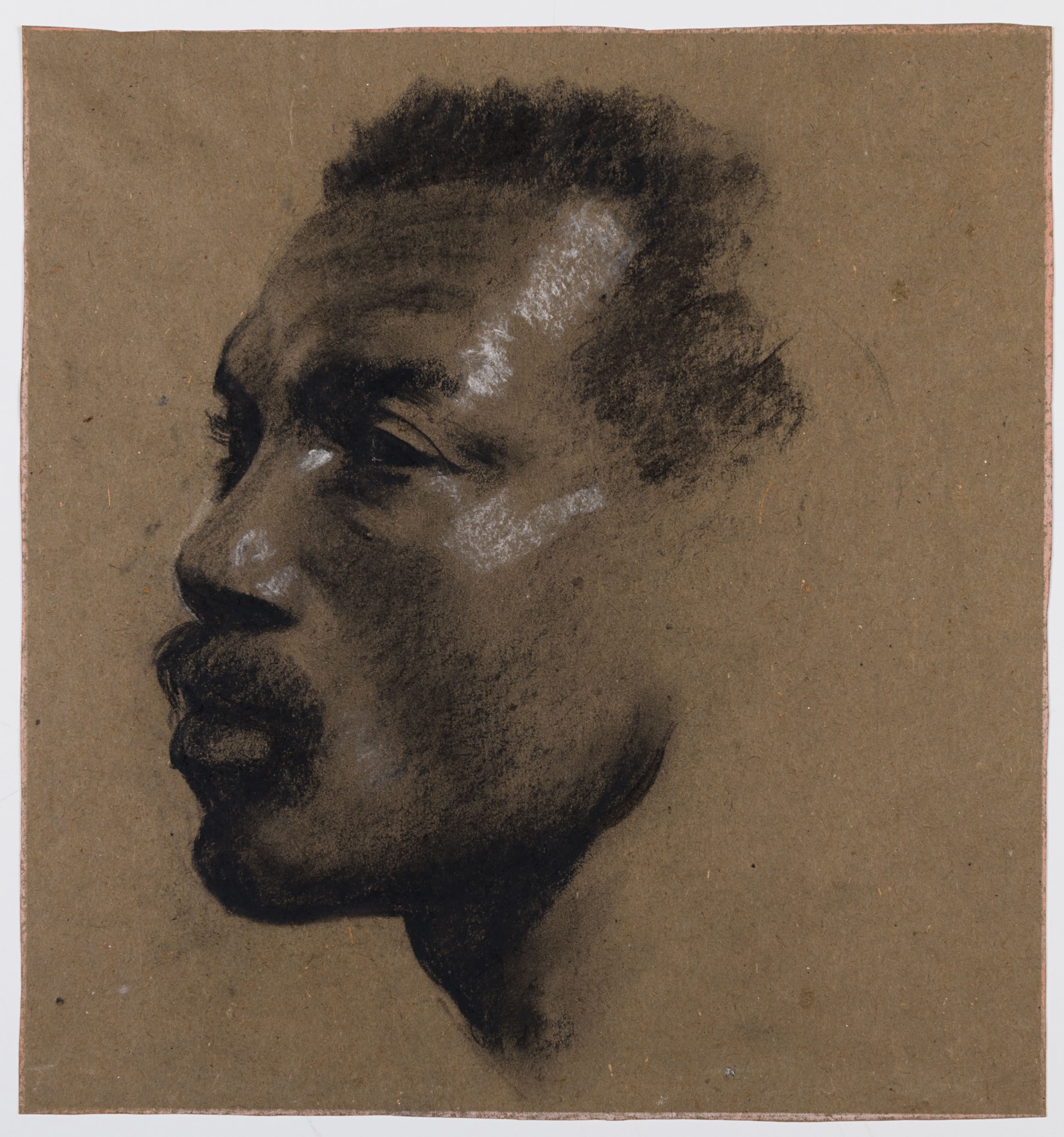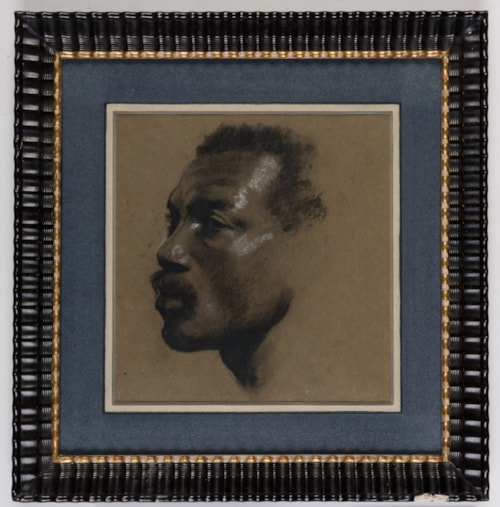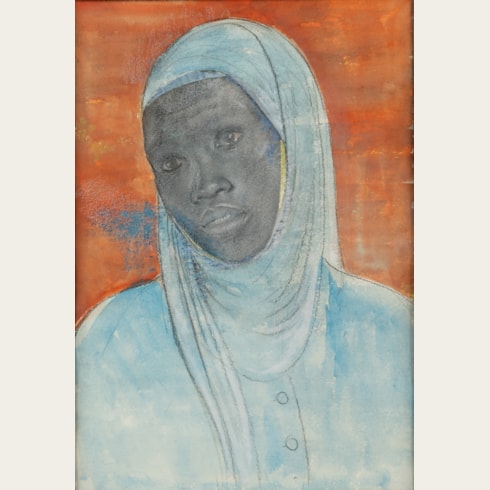Glyn PHILPOT
(London 1884 - London 1937)
The Head of a Black Man (‘Billy’)
Sold
Charcoal, heightened with white chalk, on brown paper.
275 x 261 mm. (10 7/8 x 10 1/4 in.)
RECENTLY ACQUIRED BY THE NATIONAL GALLERY OF CANADA, OTTAWA.
275 x 261 mm. (10 7/8 x 10 1/4 in.)
RECENTLY ACQUIRED BY THE NATIONAL GALLERY OF CANADA, OTTAWA.
Glyn Philpot’s superb draughtsmanship is readily evident in his work as a painter, and the present sheet is one of the earliest examples of an interest in the black male form that was to be a recurring motif in his oeuvre throughout his career. As his biographer has pointed out, ‘Black models…were not common in the work of artists of Glyn’s own time and earlier…What makes Glyn unique was that black men became a major theme in his paintings done in London and Paris, and the inspiration of some of his best work.’
This charcoal drawing may be dated to c.1912-1913, and depicts one of the artist’s first black models, identified only as ‘Billy’ in another drawing exhibited at the Modern Society of Portrait Painters in 1913, where it was shown alongside a small bust-length painting of the same sitter, now in a private collection. Both the drawing and the painting of ‘Billy’ - the first in a long series of depictions of black men by Philpot - were purchased at the exhibition by the politician and art collector Sir Philip Sassoon, who later commissioned a portrait from the artist. A powerful charcoal figure drawing of a standing male nude of c.1913, today in a private collection, may also depict the same model.
‘Billy’, the sitter of this drawing, reappears in Philpot’s large painting The Watcher on the Roof (also known as The Morning Prayer or The Prayer on the Roof) of 1913, which was acquired, the same year that it was painted, by the National Gallery of Canada in Ottawa. The present sheet may, in fact, have been intended as a preparatory study for the Ottawa painting.
Writing in 1921, the art critic Sir Claude Phillips noted of Philpot that ‘He has the gift, uncommon in these days, of bringing out all that is latent in the negro type of pathetic appeal. Rubens and Van Dyck, Rembrandt and his followers amongst the seventeenth century Dutch painters had this gift, but among moderns Mr. Glyn Philpot stands alone in the seriousness, the pathos, with which he has approached and solved an attractive problem.’
This charcoal drawing may be dated to c.1912-1913, and depicts one of the artist’s first black models, identified only as ‘Billy’ in another drawing exhibited at the Modern Society of Portrait Painters in 1913, where it was shown alongside a small bust-length painting of the same sitter, now in a private collection. Both the drawing and the painting of ‘Billy’ - the first in a long series of depictions of black men by Philpot - were purchased at the exhibition by the politician and art collector Sir Philip Sassoon, who later commissioned a portrait from the artist. A powerful charcoal figure drawing of a standing male nude of c.1913, today in a private collection, may also depict the same model.
‘Billy’, the sitter of this drawing, reappears in Philpot’s large painting The Watcher on the Roof (also known as The Morning Prayer or The Prayer on the Roof) of 1913, which was acquired, the same year that it was painted, by the National Gallery of Canada in Ottawa. The present sheet may, in fact, have been intended as a preparatory study for the Ottawa painting.
Writing in 1921, the art critic Sir Claude Phillips noted of Philpot that ‘He has the gift, uncommon in these days, of bringing out all that is latent in the negro type of pathetic appeal. Rubens and Van Dyck, Rembrandt and his followers amongst the seventeenth century Dutch painters had this gift, but among moderns Mr. Glyn Philpot stands alone in the seriousness, the pathos, with which he has approached and solved an attractive problem.’
Born in Clapham, Glyn Warren Philpot studied at the Lambeth School of Art in London and, later, at the Académie Julian in Paris, under the painter Jean-Paul Laurens. Among his earliest paintings were portraits of his family and friends, since he could not afford professional models, and in 1904 he first showed a picture at the Royal Academy. He also began organizing small exhibitions, at borrowed studios and galleries, in order to bring his work to a wider audience. In 1906 Philpot began working from the first of a series of studios in Chelsea and exhibited at the Society of Portrait Painters. Three years later he began showing with the breakaway Modern Society of Portrait Painters, and in 1910 had his first significant one-man exhibition in a London art gallery, which was a modest critical and commercial success. Aptly described, by one friend who met the artist at around this time, as ‘a young man of brilliant powers who nevertheless was a traditionalist from the start and not a revolutionary’, Philpot counted among his early accomplishments a portrait of a Spanish bullfighter, painted in 1909, that received much critical praise, and a painting of The Marble Worker of 1911, which won the Gold Medal at the Carnegie International Exhibition in Pittsburgh two years later.
In 1912 Philpot became a member of the International Society of Sculptors, Painters and Gravers, exhibiting with them for the next twelve years. Seen by many as the heir to John Singer Sargent, he developed a highly successful career as a society portrait painter, earning between ten and twelve commissions a year and sending paintings to the annual exhibitions at the Royal Academy. He also produced a small number of sculptures in bronze, and painted mural decorations for the dining room of Port Lympne in Kent for Sir Phillip Sassoon. Elected an Associate of the Royal Academy in 1915, Philpot became the youngest Royal Academician on his full election to the institution in 1923, and in the same year was the subject of a large retrospective exhibition at the Grosvenor Galleries. Much admired for his refined draughtsmanship, confident technique and sense of colour, Philpot earned a considerable income from his portrait commissions and enjoyed a lavish lifestyle, with homes in London and Sussex. In 1927 he painted a mural for St. Stephen’s Hall in Westminster, and in 1930 produced another for the home of Lord and Lady Melchett in London. In the same year he was honoured with a solo exhibition at the Venice Biennale and joined Henri Matisse on the jury for the Carnegie International in Pittsburgh.
In 1931 Philpot decided to move to Paris, which was to prove a turning point in his career. It was in the early 1930s that his style changed dramatically, under the influence of Picasso and Matisse and the art that he encountered in Paris. Bored by portraiture, he began to experiment with new techniques and subjects in paintings which he first showed at the summer exhibition of the Royal Academy in 1932. His newer work found much less acceptance with critics and collectors, however, and many were quite scathing in their assessment of it. (A headline in The Scotsman in 1932 declared that ‘Glyn Philpot “Goes Picasso”’.) Philpot lost several of his former clients, who were unhappy with his new, more ‘modern’ style of painting, and his income suffered greatly, forcing him to sell his country house in West Sussex. During the 1930s exhibitions of his recent paintings and sculptures were held at the Leicester and Redfern Galleries in London, while he continued to travel abroad; to North Africa, Spain and France. He also began producing still life compositions and watercolours, which were easier to sell.
After Philpot’s sudden death from heart failure in December 1937, at the age of just fifty-three, a memorial exhibition was held at the Tate Gallery the following summer, although it included no drawings. The subsequent turmoil of the Second World War, however, meant that his work was largely forgotten in later years, despite a handful of museum exhibitions; in Brighton in 1953, London in 1959 and Worthing in 1962. As one critic, writing on the occasion of another exhibition, at the Ashmolean Museum in Oxford in 1976, noted ‘Philpot’s unerring skill both in drawing and handling of paint, the wide-ranging originality of his subject pictures, and the careful yet sensitive characterisation of his portraits all compare favourably with the half dozen or so early twentieth-century British artists who have become household names. How is it, then, that with these qualities, one of the most sought-after society portrait painters of his time…can have slipped so quickly from the public mind?’ In 1984, however, a large retrospective exhibition of Philpot’s work, with a particular focus on his portraiture, was held at the National Portrait Gallery in London. More recently, a major exhibition of his oeuvre as a painter and draughtsman, in which the present sheet was included, was shown in 2022 at the Pallant House Gallery in Chichester.
Philpot’s superb draughtsmanship is readily evident in his work as a painter, and he was particularly noted for his skill in life drawing. One of the largest extant collections of drawings by the artist is a group of some four hundred sheets, mainly chalk, pencil and charcoal studies from sketchbooks, discovered in a storeroom in one of Philpot’s old London studios in 1957 and presented in 1962 to the Courtauld Gallery by his niece, Gabrielle Cross. Other significant groups of drawings by the artist are in the British Museum and the Victoria and Albert Museum in London and the Ashmolean Museum in Oxford.
In 1912 Philpot became a member of the International Society of Sculptors, Painters and Gravers, exhibiting with them for the next twelve years. Seen by many as the heir to John Singer Sargent, he developed a highly successful career as a society portrait painter, earning between ten and twelve commissions a year and sending paintings to the annual exhibitions at the Royal Academy. He also produced a small number of sculptures in bronze, and painted mural decorations for the dining room of Port Lympne in Kent for Sir Phillip Sassoon. Elected an Associate of the Royal Academy in 1915, Philpot became the youngest Royal Academician on his full election to the institution in 1923, and in the same year was the subject of a large retrospective exhibition at the Grosvenor Galleries. Much admired for his refined draughtsmanship, confident technique and sense of colour, Philpot earned a considerable income from his portrait commissions and enjoyed a lavish lifestyle, with homes in London and Sussex. In 1927 he painted a mural for St. Stephen’s Hall in Westminster, and in 1930 produced another for the home of Lord and Lady Melchett in London. In the same year he was honoured with a solo exhibition at the Venice Biennale and joined Henri Matisse on the jury for the Carnegie International in Pittsburgh.
In 1931 Philpot decided to move to Paris, which was to prove a turning point in his career. It was in the early 1930s that his style changed dramatically, under the influence of Picasso and Matisse and the art that he encountered in Paris. Bored by portraiture, he began to experiment with new techniques and subjects in paintings which he first showed at the summer exhibition of the Royal Academy in 1932. His newer work found much less acceptance with critics and collectors, however, and many were quite scathing in their assessment of it. (A headline in The Scotsman in 1932 declared that ‘Glyn Philpot “Goes Picasso”’.) Philpot lost several of his former clients, who were unhappy with his new, more ‘modern’ style of painting, and his income suffered greatly, forcing him to sell his country house in West Sussex. During the 1930s exhibitions of his recent paintings and sculptures were held at the Leicester and Redfern Galleries in London, while he continued to travel abroad; to North Africa, Spain and France. He also began producing still life compositions and watercolours, which were easier to sell.
After Philpot’s sudden death from heart failure in December 1937, at the age of just fifty-three, a memorial exhibition was held at the Tate Gallery the following summer, although it included no drawings. The subsequent turmoil of the Second World War, however, meant that his work was largely forgotten in later years, despite a handful of museum exhibitions; in Brighton in 1953, London in 1959 and Worthing in 1962. As one critic, writing on the occasion of another exhibition, at the Ashmolean Museum in Oxford in 1976, noted ‘Philpot’s unerring skill both in drawing and handling of paint, the wide-ranging originality of his subject pictures, and the careful yet sensitive characterisation of his portraits all compare favourably with the half dozen or so early twentieth-century British artists who have become household names. How is it, then, that with these qualities, one of the most sought-after society portrait painters of his time…can have slipped so quickly from the public mind?’ In 1984, however, a large retrospective exhibition of Philpot’s work, with a particular focus on his portraiture, was held at the National Portrait Gallery in London. More recently, a major exhibition of his oeuvre as a painter and draughtsman, in which the present sheet was included, was shown in 2022 at the Pallant House Gallery in Chichester.
Philpot’s superb draughtsmanship is readily evident in his work as a painter, and he was particularly noted for his skill in life drawing. One of the largest extant collections of drawings by the artist is a group of some four hundred sheets, mainly chalk, pencil and charcoal studies from sketchbooks, discovered in a storeroom in one of Philpot’s old London studios in 1957 and presented in 1962 to the Courtauld Gallery by his niece, Gabrielle Cross. Other significant groups of drawings by the artist are in the British Museum and the Victoria and Albert Museum in London and the Ashmolean Museum in Oxford.
Provenance
Given by the artist to Jessica and Dorothy Leeson
Anonymous sale, London, Christie’s, 23 June 1994, lot 127
The artist’s niece, Gabrielle Cross
The Fine Art Society, London, in 1997
Duane Edward Wilder, New York and Paris.
Anonymous sale, London, Christie’s, 23 June 1994, lot 127
The artist’s niece, Gabrielle Cross
The Fine Art Society, London, in 1997
Duane Edward Wilder, New York and Paris.
Literature
Simon Martin, Glyn Philpot: Fresh and Spirit, exhibition catalogue, Chichester, 2022, p.29, fig.18.
Exhibition
London, The Fine Art Society, Glyn Philpot RA: Paintings, drawings and sculptures from the Estate of Gabrielle Cross, 1997-1998, no.30; Chichester, Pallant House Gallery, Glyn Philpot: Fresh and Spirit, 2022.






